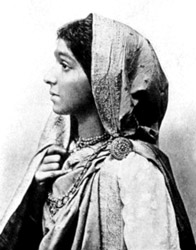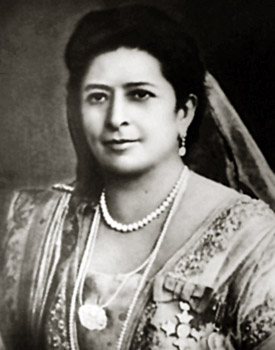All Indian Women`s Conference (AIWC) was one of the later women`s organisations formed in pre-Independent India. The origins of the Conference lie in the encouragement given by Mr. Oaten, the director of Public-Instruction in Bengal to women`s education. He urged women to decide what kind of education was suitable for Indian girls and then continue to tell the Government this till they achieved it. A reply to this was published in Stri Dharma and this eventually led to plans for a Conference. Margaret Cousins sent circular letters to women leaders throughout India suggesting that they organize local conferences to discuss educational issues. Each conference would prepare a memorandum on female education for presentation at an all-India Conference to be held at Pune.
First Conference of the AIWC
At the first meeting of the Conference there were eighty-seven members from the local reception committee, fifty-eight delegates from local conferences and over 2,000 observers, both men and women. The Rani Saheb of Sangli delivered the opening address and introduced the first president, the Maharani Chimnabai Saheb Gaekwad of Baroda. In her opening remarks the Rani insisted that women needed a special type of education. This did not imply a feminist education as it meant creating antagonism and ill will between men and women. What was meant by this special kind of education was knowledge that would help them understand their position as "supplemental" to that of men. The Maharani of Baroda focused on social customs - especially Purdah system and child marriage - which hampered the growth of female literacy. This was a time of women`s awakening, she said, noting women`s new interest in politics, but she too called for education compatible with "women`s nature."
Delegates to the Conference included a large number of professional educationalists as well as social reformers, women associated with the nationalist movement, and the wealthy and titled. The general agreement regarding the best kind of education for females included basic assumptions about women`s place in society. The delegates favoured an educational system that would allow for the fullest development of the individual`s latent capacities. But at the same time they wanted to teach all girls the ideals of motherhood, how to make the home attractive, and how to help others. Their more specific resolutions stressed the importance of moral and physical education, deplored child marriage, and urged special arrangements for educating women in Purdah.
It is interesting to note that All Indian Women`s Conference did not advocate mass education for all women nor did they envision a world where all middle-class and upper-class women would receive the same education as men. The majority of the women at the Conference agreed that the educational system should concentrate on producing educated wives and mothers but they also wanted women doctors, professors, and lawyers. Regardless of whether the curriculum stressed home science or natural science, there was general agreement that education should complement gender roles.
In their discussion of female education, delegates to the Conference commented on women`s role historically. They maintained that in ancient India women had equal access to education, political power, and wealth. Social customs, particularly child marriage and Purdah, had actually resulted from foreign invasions and prevented women from receiving educational instruction. This kind of an interpretation of history, of a glorious past followed by a dark age, went a long way in legitimizing the organisation and the focus of its programs. However, it also in a way limited its appeal to all sections of women as the foreigners who were being blamed for the fall in women`s status were the Muslims.
Program for Action
By 1928 the All-India Women`s Conference on Educational Reform decided there could be little progress in educational matters unless harmful social customs were eradicated. The next year the AIWC widened its scope to include all questions of social welfare and declared their main activity to be organizing public opinion on these issues. With the 1930s came the civil disobedience movement and the organization`s decision to remain apolitical. In making this choice the AIWC opted to preserve its identity as a petitioning organization.
The organization faced a similar decision as the number and range of social issues grew. Beginning with education, then adding social customs which restricted female education, notably child marriage and Purdah, the AIWC continued to enlarge its purview. By the mid-1930`s the list of sub-committees included labour, rural reconstruction, indigenous industries, textbooks, opium, and the Sarda Act. At the same time their resolutions ranged from advocating film censorship to urging widespread instruction in birth control. The leaders were aware their work was taking them in two directions: one that would benefit women specifically and one aimed at helping the entire nation.
Challenges faced by the AIWC
Their work on behalf of women was increasingly focused on legal disabilities while concern with the welfare of the nation led them towards Mahatma Gandhi`s program of reconstruction and social action. Their interest in women`s status in law led to increased collaborations with British officials and members of the legislature while the Gandhian emphasis on village uplift and untouchables involved work at the grass-roots level.
These contradictions became marked by 1936. In her presidential address that year, Margaret Cousins reviewed the progress of the AIWC since its inception. She recalled the first Conference as representing the intelligentsia whereas, in 1936, the AIWC included a "solidarity of sisters" ranging from Maharanis to Harijans. In her final statements Cousins encouraged AIWC members to continue their work on all fronts. Margaret Cousins` optimism about the solidarity of the sisterhood actually masked certain deep-seated problems which within the organisation.
At the end of the 1930s and in the early 1940s the AIWC faced a series of challenges. It was questioned whether or not the organisation could seriously claim that it represented and spoke on behalf of all women. Amrit Kaur, one of Gandhi`s devoted followers, wanted the organization to emerge as a political force for women. This proposal was voted down. The AIWC was committed to a comprehensive legal bill for women. This project was not popular with Muslim women, many of whom believed Muslim law came from the Quran and could not be tampered with. Efforts to bring lower-class rural and urban women into the organization mainly focussed on reducing the membership dues to 4 annas rather than developing any kind of a program that would interest these women. None of these problems was solved at the national level.
However the AIWC was able to overcome all these problems and establish itself as the premier organisation representing women. In 1941 the AIWC established its quarterly journal, Roshni, and in 1946 set up a central office with a permanent staff. With the organizational details complete they could devote their energy now to the two major tasks that they had undertaken- publicity and propaganda on women`s issues, and research to provide a data base on women in India.
The provincial branches took on new life during the war years. Some of these organisations took up local issues, supporting peasant movements, teaching untouchables, encouraging political involvement and so on. They reached out to the women whom the central body had ignored. Even though this was hard work the organisation persisted. Thus the AIWC was one of the most important organisations that emerged in colonial India and it went a long way in educating and empowering women during the time.













